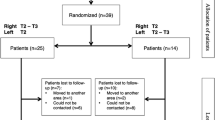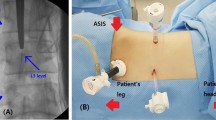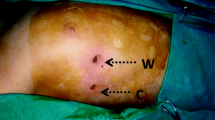Abstract
Background
Palmoplantar hyperhidrosis is a common disease that leads to significant psychosocial strain for the affected person. Although the treatment of palmar symptoms with endoscopic thoracic sympathectomy (ETS) is clinically established, there are few data on the efficacy of an endoscopic lumbar sympathectomy (ELS) for the elimination of plantar symptoms. Especially the occurrence of unwanted side effects associated with sequential ETS and ELS has not been examined sufficiently.
Methods
The study includes 130 patients, 8 men and 122 women, with severe palmoplantar hyperhidrosis who were already previously treated with ETS. An average of 28 months after the ETS, bilateral ELS was performed on all patients due to persistent severe plantar hyperhidrosis. After ELS the perioperative morbidity, elimination rate of the plantar hyperhidrosis, the frequency of unwanted side effects, and satisfaction with the result were evaluated. Follow-up examinations were carried out on 96 patients (74%) with a mean follow-up of 37 months (3–90 months).
Results
A total of 260 lumbar sympathectomies were successfully carried out endoscopically. Mortality was zero, intraoperative complications occurred in three (2.3%) patients and postoperative complications in six (4.6%). Plantar hyperhidrosis was eliminated in 93 patients (97%), 3 (3%) patients developed a one-sided recurrence. Seven patients (7%) developed minor compensatory sweating, and in 17 patients (18%) compensatory sweating that existed before the ELS was slightly increased. Transient postsympathectomy neuralgia was observed in 18 patients (19%), and none of the patients showed a sexual function disorder. Altogether, 77 patients (80%) were very satisfied with the postoperative result, and 16 (17%) were partially satisfied.
Conclusions
The sesequential performance of ELS after ETS appears to be a safe, effective therapy option for patients with severe palmoplantar hyperhidrosis. However, more experience with a larger number of patients and longer follow-up investigations are necessary to confirm the safety of four-limb sympathectomy.
Similar content being viewed by others
References
Eisenach JH, Atkinson JL, Fealey RD (2005) Hyperhidrosis: evolving therapies for a well-established phenomenon. Mayo Clin Proc 80:657–666
Hornberger J, Grimes K, Naumann M et al (2004) Recognition, diagnosis, and treatment of primary focal hyperhidrosis. J Am Acad Dermatol 51:274–286
Adar R, Kurchin A, Zweig A et al (1977) Palmar hyperhidrosis and its surgical treatment: a report of 100 cases. Ann Surg 186:34–41
Drott C, Göthberg G, Claes G (1995) Endoscopic transthoracic sympathectomy: an efficient and safe method for the treatment of hyperhidrosis. J Am Acad Dermatol 33:78–81
Kux M (1978) Thoracic endoscopic sympathectomy in palmar and axillary hyperhidrosis. Arch Surg 113:264–266
Rieger R, Pedevilla S, Pöchlauer S (2008) Therapie der palmaren und axillären Hyperhidrose-Thorakoskopische Resektion des Truncus sympathicus. Chirurg 79:1151–1161
Tetteh HA, Groth SS, Kast T et al (2009) Primary palmoplantar hyperhidrosis and thoracoscopic sympathectomy: a new objective assessment method. Ann Thorac Surg 87:267–274
Loureiro MP, Milanez De Campos JR, Kauffman P et al (2008) Endoscopic lumbar sympathectomy for women: effect on compensatory sweat. Clinics 63:189–196
Nicolas C, Grosdidier G, Granel F et al (2000) Endoscopic sympathectomy for palmar and plantar hyperhidrosis: results in 107 patients. Ann Dermatol Venereol 127:1057–1063
Rieger R, Pedevilla S, Pöchlauer S (2009) Endoscopic lumbar sympathectomy for plantar hyperhidrosis. Br J Surg 96:1422–1428
Rieger R, Pedevilla S (2007) Retroperitoneoscopic lumbar sympathectomy for the treatment of plantar hyperhidrosis: technique and preliminary findings. Surg Endosc 21:129–135
Chen HJ, Shih DY, Fung ST (1994) Transthoracic endoscopic sympathectomy in the treatment of palmar hyperhidrosis. Arch Surg 129:630–633
Herbst F, Plas EG, Függer R et al (1994) Endoscopic thoracic sympathectomy for primary hyperhidrosis of the upper limb: a critical analysis and long term results of 480 operations. Ann Surg 220:86–90
Andrews BT, Rennie JA (1997) Predicting changes in the distribution of sweating following thoracic sympathectomy. Br J Surg 84:1702–1704
Neumayer CH, Panhofer P, Zacherl J et al (2005) Effect of endoscopic thoracic sympathetic block on plantar hyperhidrosis. Arch Surg 140:676–680
Chou SH, Kao EL, Lin CC et al (2006) The importance of classification in sympathetic surgery and a proposed mechanism for compensatory hyperhidrosis: experience with 464 cases. Surg Endosc 20:1749–1753
Kopelman, Hashmonai M (2008) The correlation between the method of sympathetic ablation for palmar hyperhidrosis and the occurrence of compensatory hyperhidrosis: a review. World J Surg 32:2343–2356
Nickel J, Jahnel A, Andresen R (2004) CT-gestützte lumbale Sympathikolyse bei Hyperhidrosis plantaris. Rofo 176(Suppl):122–124
Kim WO, Yoon KB, Kil HK et al (2008) Chemical lumbar sympathetic block in the treatment of plantar hyperhidrosis: a study of 69 patients. Dermatol Surg 34:1340–1345
Whitelaw GP, Smithwick RH (1951) Some secondary effects of sympathectomy: with particular reference to disturbance of sexual function. N Engl J Med 245:121–130
Conflicts of interest
The authors declare no conflicts of interest.
Author information
Authors and Affiliations
Corresponding author
Rights and permissions
About this article
Cite this article
Rieger, R., de Paula Loureiro, M., Pedevilla, S. et al. Endoscopic Lumbar Sympathectomy Following Thoracic Sympathectomy in Patients with Palmoplantar Hyperhidrosis. World J Surg 35, 49–53 (2011). https://doi.org/10.1007/s00268-010-0801-0
Published:
Issue Date:
DOI: https://doi.org/10.1007/s00268-010-0801-0




